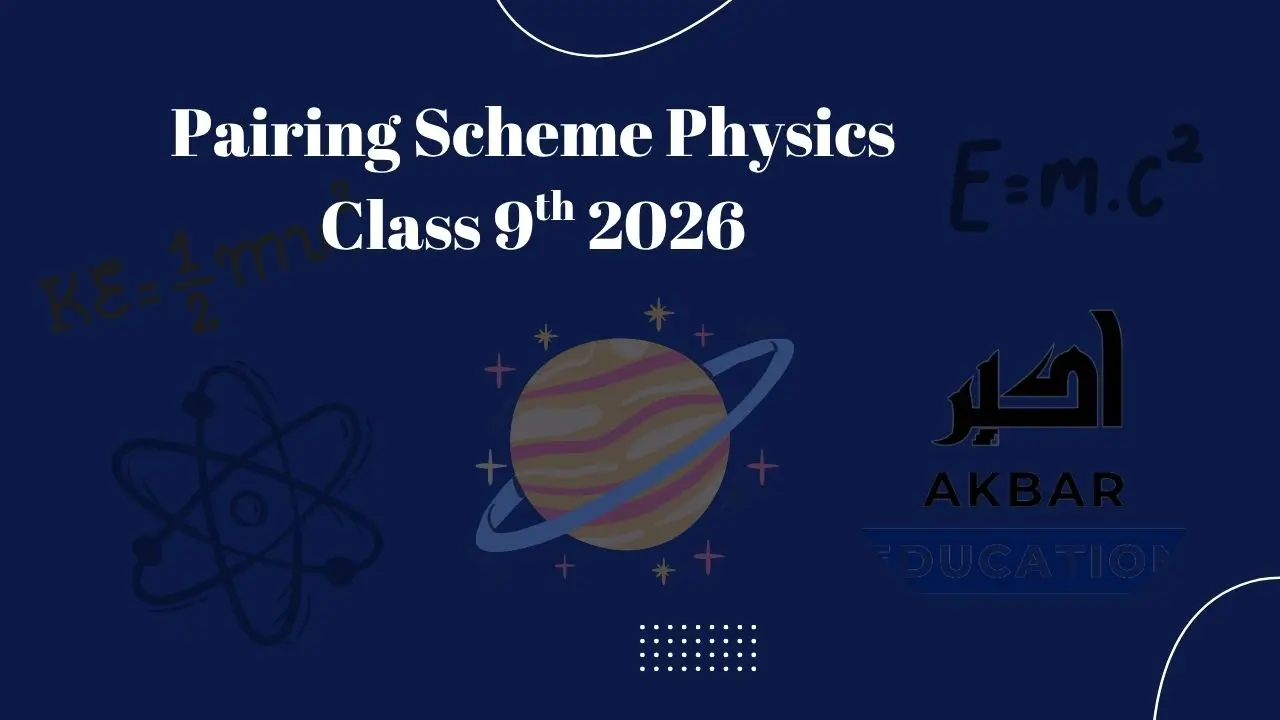Preparing for the annual board exam in physics for Class 9 can feel daunting—but with the right roadmap and understanding of the pairing scheme (paper‐pattern) for the year 2026, you can streamline your study, focus on high‐yield chapters, and maximize your performance.

What is a Pairing Scheme and Why Does It Matter?
The “pairing scheme,” also called the “paper scheme,” is essentially a breakdown of how the exam paper will be structured: how many MCQs, how many short questions, how many long questions, which chapters will carry questions, and how frequently. It gives you insight into:
- the marks distribution (MCQs vs short vs long)
- the chapter-wise weightage (which chapters are more likely to be asked)
- the question format (attempt all vs attempt any x out of y)
- the focus areas (numericals, theory, definitions)
For example, PECTA disclosed that for Class 9 Physics under Punjab Boards, the pairing scheme for 2026 is laid out: MCQs (12 marks), short questions, and long questions as separate segments.
Knowing the scheme gives you a roadmap to study smart (not just hard): you can prioritize high-probability chapters, allocate time to challenging numericals, and build confidence.
Latest Updates for the 2026 Examination
For the 2026 exam cycle, there are a few key updates you should be aware of:
- The syllabus and pairing scheme frameworks have been gradually updated under the ALP (Accelerated Learning Programme) and the single-national-curriculum initiatives. Download the Class 9th pairing scheme physics 2026 from the link below.
How to Use the Pairing Scheme Smartly for Exam Preparation
Here are actionable strategies to maximize your preparation:
- Get the Official PDF Early
Download the pairing scheme as soon as your board publishes it (or rely on trusted websites). Always use the 2026 scheme when available. For example, websites like Akbar Education emphasize updated pairing schemes. - Map Out Your Study Schedule According to Weightage
Use the scheme to create a timetable: chapters with more weightage or numericals get more time. For example, if chapter 3 has 2 MCQs and appears in two long questions historically, allocate extra time to it. - Formula & Units Sheet
Because MCQs and short questions often test basic definitions and units, maintain a separate “Formula & Units” notebook. This helps rapid revision, especially for the MCQ section. - Practice Numericals Strategically
Identify chapters in the scheme that require numericals (e.g., Gravitation, Work & Energy). Use past paper numericals and practise them under timed conditions. - Short & Long Question Practice
- For short questions: practice questions that match the chapter-allocation in the scheme
- For long questions: pick past long question formats (theory vs numericals) and simulate full answers. Use the scheme to know which chapters likely will come.
- Diagram/Graph Practice
Many Physics questions require clean labelled diagrams (waves, motion graphs, force diagrams). Practise drawing them quickly and accurately. - Revision Sessions
Use the pairing scheme to plan revision: e.g., reserve last 2 weeks for high-weight chapters and weak areas. Use scheme to ensure you don’t ignore any chapter. - Mock Exams
Set mock papers that follow the same structure as the scheme (e.g., 12 MCQs, short Qs any 5/8, 2 long questions etc). This will familiarise you with timing and question distribution.
Common Mistakes and How to Avoid Them
- Ignoring the pairing scheme and trying to cover everything equally → you may waste time on low-weight chapters.
- Not practicing long questions even when scheme shows them from specific chapters → leads to loss of big marks.
- Memorizing formulas without understanding → numericals will be difficult.
- Skipping diagrams/graphs: If a chapter is diagram-heavy, you lose easy marks.
- Using outdated schemes: For the 2026 exam, use the 2026 scheme or the latest version; the 2025 scheme is a guide but may differ.
Final Thoughts
The pairing scheme for Class 9 Physics 2026 is your blueprint for exam success. By understanding the structure of MCQs, short and long questions, knowing which chapters carry more weight, and aligning your preparation accordingly, you’ll be far ahead of many students. Focus more on high-yield chapters, practice numericals & diagrams, revise formulas, and simulate exam conditions. Always check for any official updates by your board, because even slight changes in pattern can impact your approach.
Wishing you strong preparation and excellent results for your Class 9 Physics board exam in 2026! If you like, I can help you download the up-to-date pairing scheme PDF for your specific board (Punjab, KPK, Sindh, or Federal) — would you like me to fetch that?
